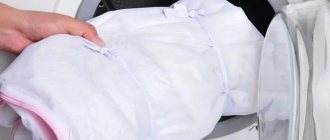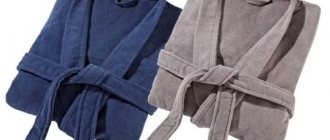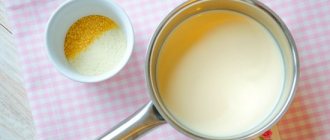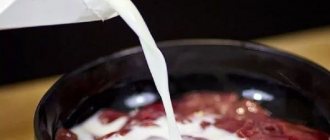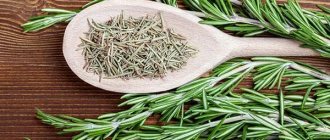How to bleach tulle with salt and soda
If it seems to you that the color of the daytime curtains is no longer as white as you would like, try bleaching the tulle with salt and soda.
You will need boiling water - 7-10 liters, 200 grams of salt, 2 heaped tablespoons of soda and a good portion of washing powder - approximately 150-200 grams. Dissolve all dry ingredients in boiling water, wait until it cools enough to hold your hand in it. Dip the tulle into the bleaching solution, stir and leave for 6 hours.
Afterwards, the fabric must be wrung out, rinsed thoroughly and dried. If the curtain is heavily soiled, after soaking it should be washed in the washing machine on the “wash delicate fabrics” setting.
Tulle bleaching recipes
You can bleach tulle while soaking, during washing and immediately after it (for silk products).
Soak
This is the easiest way.
- Pour water into the basin (its temperature should correspond to the type of fabric).
- Pour baking soda into it. For tulle with a normal level of soiling, half a pack is enough, for heavy soiling - 2/3.
- Stir the baking soda until completely dissolved.
- Put some tulle there.
- Leave to soak for several hours to a day.
- Wash using your preferred method - by hand or in the washing machine.
Sometimes, after soaking with soda, you don’t even need to wash it. Just rinse and dry the curtains.
We suggest you read why the automatic washing machine does not heat the water
To enhance the effect, you can add laundry soap to the previous recipe.
- Before putting the tulle in the basin, wet it with warm water and rub it thoroughly with laundry soap.
- Dip into a container of baking soda and leave to soak.
- After soaking, machine wash or simply rinse.
Boiling
If heavily soiled, linen or cotton tulle can be boiled. You can do this in a machine, setting the temperature to maximum, or the old fashioned way - in a large saucepan:
- Fill the container with water so that there is room for the prepared items.
- Grate the laundry soap.
- Dilute soap and soda in water at the rate of 1 glass of each product per 5 liters of water.
- Let the water boil.
- Wait for the soap and baking soda to dissolve. To speed up the process, constantly stir the liquid with a long wooden stick (if you still have special wooden tongs from Soviet times, use them).
- Gently place the curtains into the pan, but do not compact them.
- Bring to a boil and keep on fire for 40 minutes to 2 hours.
- Stir occasionally, immersing all parts of the curtains in the solution.
- After turning off, leave the textile to cool in the pan.
- Rinse thoroughly, changing the water several times (you can use a double rinse in your machine).
Table salt has a bleaching effect due to the chlorine it contains. Therefore, you should not use it for washing and soaking fabrics that cannot tolerate this substance. In other cases, it enhances the effect of soda.
Components:
- 7 liters of boiling water;
- 180 g washing powder;
- 200 g salt;
- 2 tsp. soda
Mode of application:
- Pour the mixture into boiling water, stir.
- Cool the solution to the permissible temperature.
- Place the tulle in this water and leave for 5-6 hours.
- Rinse or (if you are not satisfied with the result) wash in the washing machine.
Vinegar works well on greasy stains. In addition, its mixture with soda gives the effect of oxygen-containing bleach. But the recipe is applicable only for natural fabrics.
- To soak the tulle, use slightly warm water.
- Dilute baking soda (1/2 pack) and a glass of 6% vinegar in it.
- Leave for several hours.
- After soaking is complete, wash the curtains as usual.
Using hydrogen peroxide and baking soda together, you can create an effective oxygen bleach for delicate fabrics. During the soaking and washing process, hydrogen peroxide breaks down into water and oxygen ions, which have a bleaching effect. When added to warm water, the reaction intensifies.
Carefully! You can only use three percent (3%) peroxide (it is sold in pharmacies). A more concentrated solution may cause chemical burns to tissues.
The essence of the technique:
- Take 2 liters of water (40–60 °C for natural fabrics, up to 35 °C for synthetic fabrics).
- Add 1 tsp. peroxide and soda.
- Soak tulle in this solution (natural - for 20 minutes, delicate synthetic or mixed fabric - for 10-15 minutes).
- Rinse thoroughly.
- Wash if necessary (this step is optional).
We suggest you familiarize yourself with Gentle washing of tulle
With boric acid
Boric acid works equally well in hot and cold water. This makes it an indispensable means for bleaching tulle, which does not tolerate high temperatures.
- Dissolve a handful of baking soda and a bag of boric acid in warm water.
- Soak the tulle, periodically turning it over in a basin.
- After 24 hours, machine wash on delicate cycle.
How to whiten sneakers and sneakers with soda.
Salt bleaching
Baking soda has a whitening effect, and salt enhances it even more. But not all types of tulle can be bleached with salt. Chemical formula – NaHl. It contains chlorine, so some tissues are afraid of salt:
- nylon;
- nylon;
- organza;
- jacquard;
- natural silk and others
Do not immerse in saline solution for a long time. The fibers may break down and the fabric may shrink or become deformed.
IMPORTANT: When soaking in bleach, only enamel or plastic dishes can be used.
Reviews from housewives
Irina. I once bleached it like this: I put the tulle in the bathtub, filled it with water, added salt and soda randomly. The curtain began to turn white before our eyes. I just don’t know whether it’s from the salt or the soda.
Valentina. Before washing, my grandmother soaks tulle curtains for an hour in a saline solution (a glass of salt in half a bowl of water). Then washes it by hand. The tulle is the whitest.
Ekaterina Veretennikova. I once brought old curtains from the dacha and soaked them in salt and soda, as advised. They lightened a little, but not to complete whiteness. Maybe because they were old and hung for a long time.
Tanya. I always have baking soda on hand. I use it for bleaching, and not just tulle. When I’m lazy, I just sprinkle it in, and sometimes I experiment: I’ll add one thing, then another (ammonium or boric acid, table salt and sea salt). But just soda suits me. I didn’t see much difference from using the supplements.
How to bleach white socks with soda.
Using table salt
Our grandmothers knew how to bleach tulle at home. They always added plain table salt when soaking white laundry. Therefore, the curtains made of linen and cotton in their house were always snow-white.
For soaking, take salt at the rate of 100 g per liter of water. Soak the fabric in a strong saline solution for several hours. The bleached tulle is then hand washed with laundry soap or hand wash detergent.
Afterwards, the curtain is rinsed, but not wrung out too much, and dried in a straightened state. Many people note that tulle in a saline solution begins to turn white literally before their eyes.
General recommendations
Before washing the tulle, it needs to be prepared. Then cleaning the canvases will be faster and more effective. Experienced housewives always adhere to the following sequence:
- First, the curtains are thoroughly shaken. It is best to do this on the street or balcony, as there may be more dust than it seems at first glance.
- Then the tulle is soaked in warm water with added salt for 2-2.5 hours. The amount depends on the size of the canvas and the volume of water in the basin intended for soaking. The more concentrated the saline solution, the better and faster various contaminants will be removed.
- Next, the curtains are rinsed in plenty of warm water.
- Bleaching fabrics with chlorine-free products. Otherwise, the fabric will become very thin and wear out quickly.
- Wash tulle with the addition of powder, gel or shampoo. Many housewives prefer for these purposes children's or special powders, which are considered less aggressive.
- When washing by hand, it is not recommended to strongly wring delicate tulle items. You can only slightly squeeze them out of excess liquid. If the wash is automatic, then the spin mode must be set to zero.
- You shouldn't wait for complete drying. It is better to hang washed tulle on the cornices when they are still slightly damp.
An iron is also undesirable, since such air products often do not tolerate high temperatures.
Soda and vinegar at the same time
If the tulle of the curtains is stained, and this can often happen in the kitchen, use soda and vinegar.
For pronounced stains, proceed as follows. The curtain is soaked in water. The most contaminated areas are sprinkled with soda and distributed over the surface. Then 9% or 7% table vinegar is poured directly onto the stain.
Afterwards the fabric is left for 2-3 hours. It is then rinsed, washed and dried as usual. With this treatment, the stains will dissolve and your curtain will become white again.
How to bleach synthetic tulle
With synthetic fabric, as we have already said, you need to be especially careful. Reduce the amount of salt by 2-3 times, use not hot water, but lukewarm water (+30C).
The whitening effect will be enhanced by a few drops of brilliant green - ordinary brilliant green or crystals of potassium permanganate, literally on the tip of a knife. To prevent the fabric from staining, you must first stir the composition well in the liquid, and then immerse the fabric in it. After this treatment it will be snow-white.
How to restore whiteness with salt, peroxide and ammonia
Watch from 1 min 40 sec.
If the tulle has a yellowish or gray tint, this may be caused by people smoking indoors, opening windows, and soot and dust flying from the street, or often cooking something on the stove.
In this case, the effect must be enhanced with peroxide. You will need 2 standard bottles (200 ml) of hydrogen peroxide 3% concentration and 50 g of salt. They need to be dissolved in 5 liters of hot water (t +50C). Peroxide can be replaced with ammonia, but you will need less of it - 100 ml. You need to soak the tulle for 12 hours, it is better to do it overnight. Then wash and dry as usual.
Here's how to bleach tulle yourself without harsh chemicals, without going to the dry cleaner. Let the curtains in your home delight you with sparkling cleanliness and pristine freshness.
Causes of yellowing tulle
The main reasons for changes in the color of tulle fabric are:
- influence of dust and grease;
- street soot and gases;
- washing without soaking and removing dust particles;
- use of hot water, more than 40°C, for artificial fabrics;
- tobacco smoke;
- exposure to sunlight on fabric.
To maintain the presentable appearance of tulle for a long time, it is necessary to properly care for it. It is recommended to wash tulle at least once every 3-5 months, depending on how dirty it is. Bleaching methods depend on the material from which they are made and what type of contamination is present on the fabric.
Tulle can be made from various materials:
- artificial - nylon, nylon, polyester;
- natural - these include linen, cotton, silk.
They differ in the type of weaving - mesh, organza, muslin or veil.
- Organza is a popular type of fabric. This fabric is made by twisting fibers from silk, viscose or polyester. The lightweight fabric is distinguished by its quality: it drapes, forming voluminous folds, and holds its given shape, is practically not subject to wear and detains the sun's rays. Tulle made from this type of material is the most popular.
- The grid speaks for itself. The fabric has a mesh structure that allows air and light to pass through. This type of fabric is most susceptible to collecting dust, so it is not suitable for people with allergies.
- A veil is a translucent fabric that allows light and air to pass through. A thin veil is made from silk, cotton and even wool threads. Has the property of repelling dust.
- Kisey is a special type of tulle. Consists of woven threads or strands of silk, synthetics or cotton, fastened together. Beads, glass beads, and seed beads are woven into the threads. This type of tulle does not need frequent washing.
